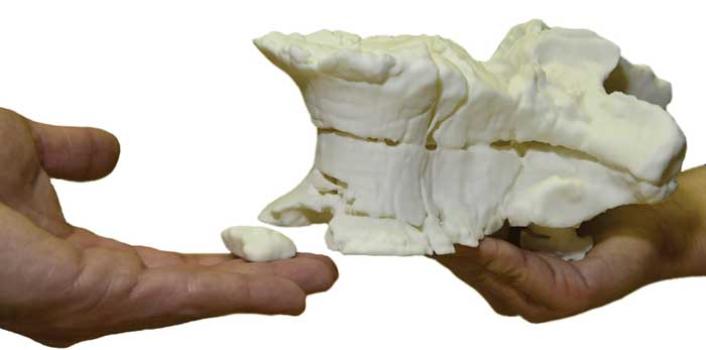Please note: Osher Rainforest will be closed for maintenance Jan. 14–16.
Science News
How to Print a Dinosaur
November 25, 2013
by Molly Michelson

Let’s face it, extracting a dinosaur fossil isn’t easy! To begin with, the fossil is often covered in sediment when it’s discovered. And then, upon removal from the dig site, scientists cover the fossil and sediment chunk in cement or plaster to keep it safe until it reaches a museum or university for further research. It requires great care and patience to extract the specimen from its natural (and artificial) enclosures…
But what happens when a fossil find gets re-buried? Recently, scientists wanted to look at a fossil from the Museum für Naturkunde, a major natural history museum in Berlin. After a World War II bombing raid, the fossil and others like it were covered by rubble in the basement of the museum. What fossil lay hidden under the rubble, plaster, and sediment? Where was it discovered? To look for the answers, the team turned to technology.
CT scans enable researchers to examine chunks like this without destroying the precious fossil beneath. So the researchers performed a CT scan on the unidentified fossil with a 320-slice multi-detector system. The different attenuation of the x-rays (or varying absorption of radiation through the bone compared with the surrounding matrix) enabled clear depiction of a fossilized vertebral body.
After studying the CT scan and comparing it to old excavation drawings, the researchers determined it belonged to a Plateosaurus and they traced the fossil’s origin to a major dig in a clay pit south of Halberstadt, Germany, which took place from 1910 to 1927. In addition, the CT study provided valuable information about the condition and integrity of the fossil, showing multiple fractures and destruction of the front rim of the vertebral body.
The team didn’t stop there. The CT dataset helped the researchers build an accurate reconstruction of the fossil with selective laser sintering, a technology that uses a high-powered laser to fuse together materials to make a 3-D object.
A dino print-out!
“The digital dataset and, ultimately, reproductions of the 3-D print may easily be shared, and other research facilities could thus gain valuable informational access to rare fossils, which otherwise would have been restricted,” says Ahi Sema Issever, MD, of Charité Campus Mitte. “Just like Gutenberg’s printing press opened the world of books to the public, digital datasets and 3-D prints of fossils may now be distributed more broadly, while protecting the original intact fossil.
“The most important benefit of this method is that it is non-destructive, and the risk of harming the fossil is minimal,” Issever continues. “Also, it is not as time-consuming as conventional preparation.”
The study is published this week in Radiology.
Image: Radiological Society of North America